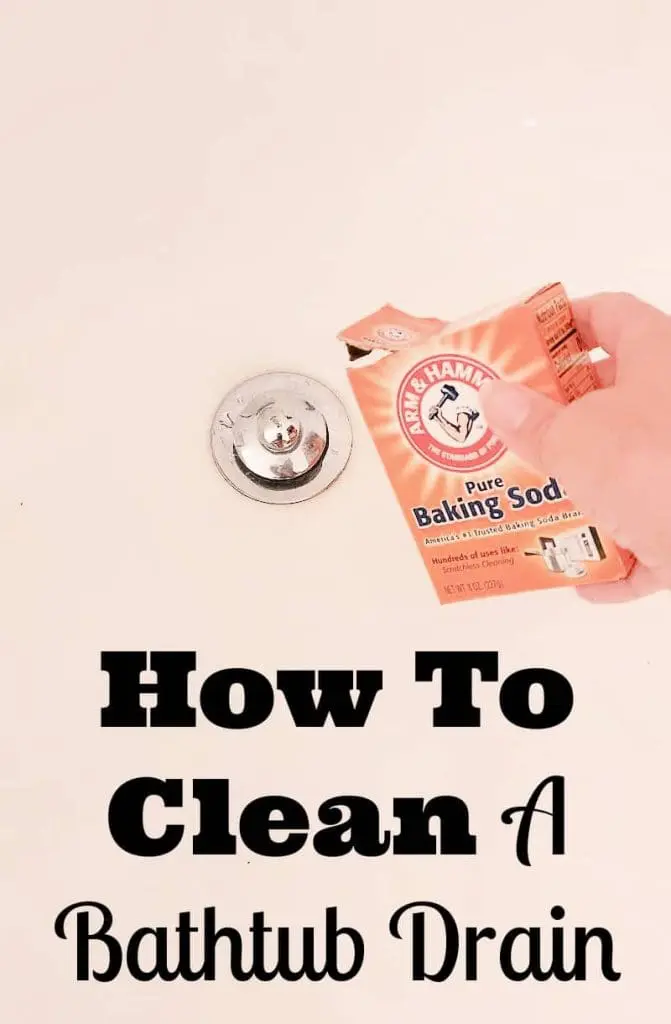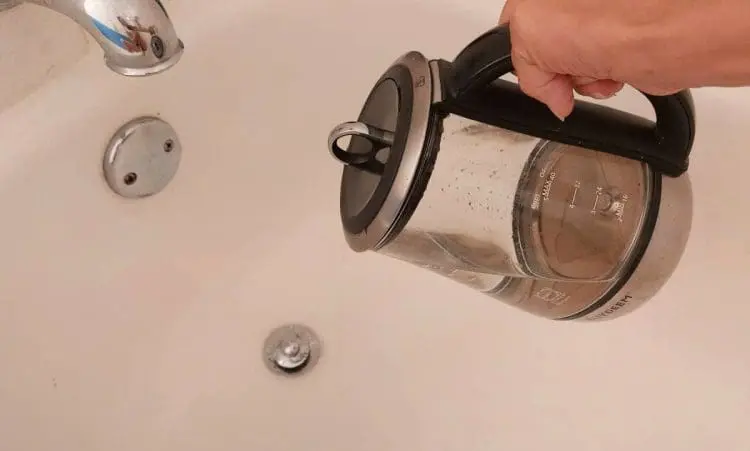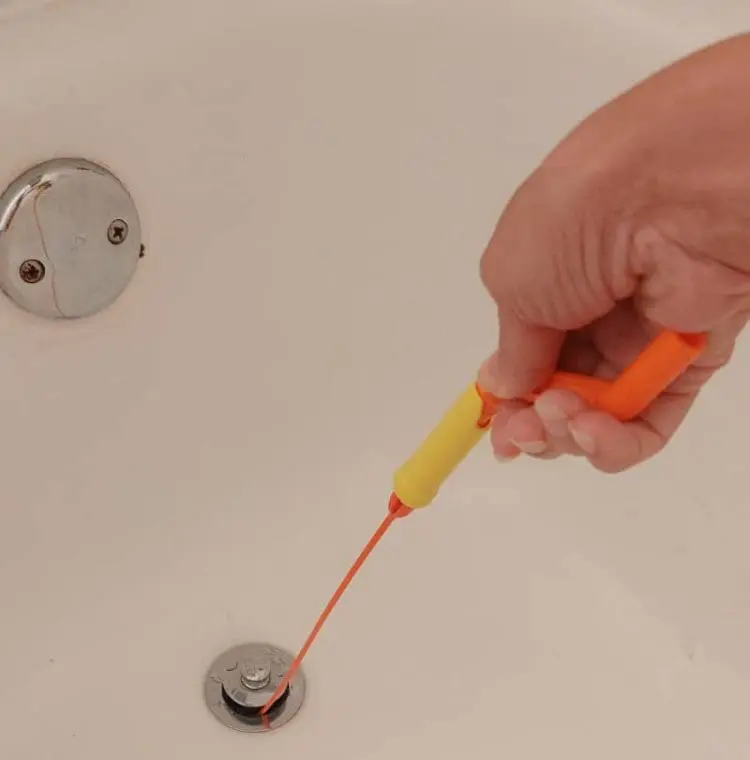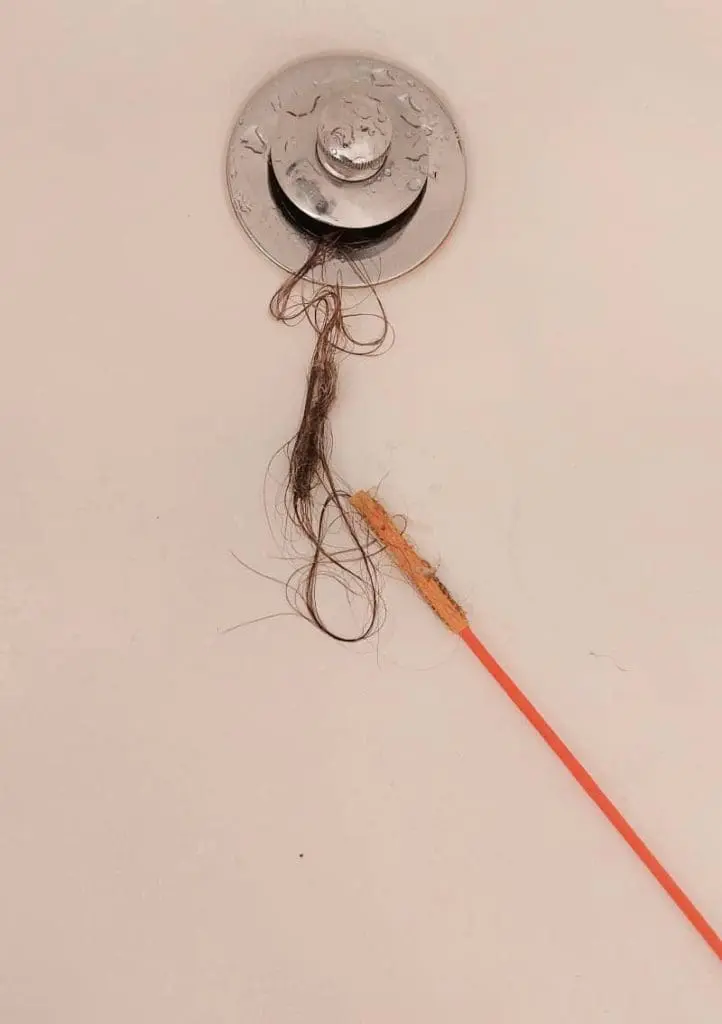You may be trying to finish your spring cleaning and just reaching the part about cleaning drains. Or if you have a daughter with long hair like I do, it is pretty much always time to clear a slow bathtub drain! When your bathtub drain gets dirty, it gets smelly and it can clog your tub. Depending on how the pipes are laid in your house, a clogged tub drain can also lead to a toilet backup or a backed-up tub in another bathroom. Cleaning your drain regularly and unclogging back ups can keep all the plumbing in your house running smoothly. It also keeps your tub from becoming smelly! Therefore, here is how to clean a bathtub drain.
3 Simple Steps To Clean Bathtub Drain

Use these tips to easily clean your bathtub drain. These instructions for how to clean bathtub drain work well for both a deep clean and to clean a bathtub drain that seems to be letting the water drain more slowly than it used to do.
However, if the drain is clogged, you’ll need to clear the clog before cleaning the drain. See the notes below for unclogging drains.
1. Deodorize
First, remove the drain stopper. Next, pour a cup of baking soda into the drain. Baking soda is a well known deodorizer as it helps absorb odor. Because baking soda is alkaline it can also help dissolve mineral deposits.
At this point you can also choose to add 1 cup of distilled white vinegar to the drain. This is optional but it will create a bubbling reaction which helps clear the drain. Plus, vinegar has some natural disinfectant properties. Additionally, as Healthline points out, its “high acidity can break down stubborn buildup of soap, dirt, and scum.”
Let the sit baking soda (and vinegar, if you decided to use it) sit for about 10 minutes. After letting it sit, use a bottle brush (Amazon affiliate link) to stick down into the drain. You can use an old toothbrush if you need a quick substitute for a bottle brush. Move it up and down, rotating it, to clean the drain and remove any loose hair.
Perform the baking soda and vinegar treatment monthly to maintain a clean drain. Regularly clean faucets, showerheads, and other fixtures with a vinegar solution to dissolve mineral buildup you may have from hard water.
2. Flush Your Drain
Follow up on deodorizing your drain by flushing your drain with boiling water (only for metal pipes).
SAFETY TIP: Be sure to use proper care and caution when carrying freshly boiled water. Be sure there are no pets or children present and that your pathway is clear before you carry the boiled water to the drain.
First, make sure the bathtub stopper is open so that water can be easily flushed down. Second, boil about 5 to 8 cups of water in a pot or kettle. Next, using safety tips above, pour the boiled water carefully down the drain (do not do this if you have plastic pipes or if you are unsure).

The hot water will flush away soap scum and loose hairs. Doing this once a week will keep your drains clear and remove any soap or hair buildup.
3. Clean Regularly
Use the tips above to deodorize and flush your drain on a regular basis. Doing this once a week or once a month (depending on light or heavy use) keeps your drains running smoothly and helps prevent future back ups.
How To Clear A Clogged Bathtub Drain
Preventative Tip: Use a drain strainer to catch hair and debris, and clean it regularly to avoid buildup.
To remove bathtub clogs without chemical drain cleaners, try one of these different methods suggested below or call a professional plumber. Always call a professional plumber if you are in doubt, especially before option 3.

1. Use a Plumber’s Tool
This is my favorite method and the option that I always use. Clogs at my house always have to do with hair stuck in the drain, so a plumber tool is most effective for us. It is the best way to get to the source of stubborn clogs. I have heard the tool referred to as a plumber’s snake, a flexisnake, a drain snake, a snake drain, a hair catcher, drain claw, and a drain auger. By any name, you use this clogged drain remover tool because it is designed especially to clear hair trapped in a drain.
The tool can be found at your local hardware store or through my Amazon Link and looks similar to a zip tie with little teeth on it that grab the hair. There is also a version called a Drain Weasel that looks more like a tiny bottle brush. Either way, the length helps poke through any clog and the plastic teeth or velcro brush hairs help catch on to the clog and pull it up.
Remove the drain cover and stick the tool into the drain as far down as it will reach. Move it around a little to grab any loose hairs, then pull it out. Hair clogs are very common. Remove the hair from the tool and repeat the steps a few times until no more hair remains in the drain. Now, you can go back to deodorizing and flushing the drain using the instructions above.

2. Plunge Your Drain
A second option is to try to plunge the drain. Remove the overflow drain faceplate (under the faucet) and place the overflow plate and screw safely on a countertop surface for later. Stuff a damp rag into the hole. This will create suction for clearing with a standard cup-style plunger. Make the hole as airtight as possible. Next, fill the tub with 2-3 inches of water, not more. Then, use a plunger to plunge the drain. Continue plunging the clogged shower drain until the clog is cleared. Remove the damp rag and screw the overflow plate back on. Now, you can deodorize and flush the drain using the instructions above.
3. Bathtub Drain Cleaner
If you’d prefer a store-bought bathtub drain cleaner, here are some eco-friendly and effective options to consider:
- Earth Enzymes Drain Opener
- Enzyme-based and safe for pipes and septic systems.
- Works well for hair and organic buildup.
- Bio-Clean Drain Septic Bacteria
- Contains natural bacteria and enzymes to break down hair, grease, and soap scum.
- Biodegradable
- Seventh Generation Drain Cleaner
- Plant-based and free from harsh chemicals.
- Safe for septic systems and eco-conscious households.
- ECOS Earth Enzyme Drain Cleaner
- Designed to prevent clogs and maintain a free-flowing drain.
- Non-Toxic & Septic-Safe
When using store-bought drain cleaners, it’s important to:
- Always Follow Instructions: Read and follow the label instructions carefully to avoid accidents or damage to plumbing.
- Septic-Safe Considerations: Not all drain cleaners are safe for septic systems, so choose a product marked “septic safe” if applicable.
- Keep Out of Reach of Children and Pets: Store cleaners in a safe place away from children and animals to avoid accidental exposure.
Cleaning Bathtub Drain Conclusion
Regular cleaning prevents hair, soap scum, and other debris from building up and causing clogs that can lead to slow draining or complete blockages. Debris and bacteria trapped in the drain can produce unpleasant odors. Cleaning the drain helps keep your bathroom smelling fresh. A clean drain reduces the risk of mold, mildew, and bacteria growth, contributing to a healthier bathroom environment.
Dirty bathtub drain? Clean it out using the drain cleaning tips above. A clean bathtub drain can keep all the plumbing in your house working at it’s best and it will keep your tub smelling fresh. It only takes a few minutes a week to keep your drain clean. This will help prevent a slow bathtub drain as well. I hope you found these tips for how to clean tub drain useful and enjoy that they are eco-friendly choices. Let us know if you have questions or tips you’d like to share on social media @familyfocusblog!
Related Posts:
Choosing The Perfect Free-Standing Bathtub for Your Bathroom

Nara says
Easy solution for very hard task. Thank you for sharing these methods that do not require harsh chemicals. As a last result I usually use an enzyme drain cleaner but now I will have methods to use before I have to go buy a cleaning product.
Pemal says
Keeping the drain clean ensures that water flows freely, preventing standing water in the tub which can be a breeding ground for bacteria. Gross! Thank you for this very comprehensive and interesting article on how to clear drain inexpensively. Regular maintenance can prevent damage to your plumbing system, which can be costly to repair.
Emma Medley says
Cleaning the tub drain is necessary for everyone. Cause once I’ve faced this problem, you know it is better to prevent than deal with standing water. Thanks for sharing how to clean bathtub drain properly and deal with tub clogs too.
Fiona Conway says
I tried your first suggestion for unclogging my drain and it worked perfectly for me. Cheers!